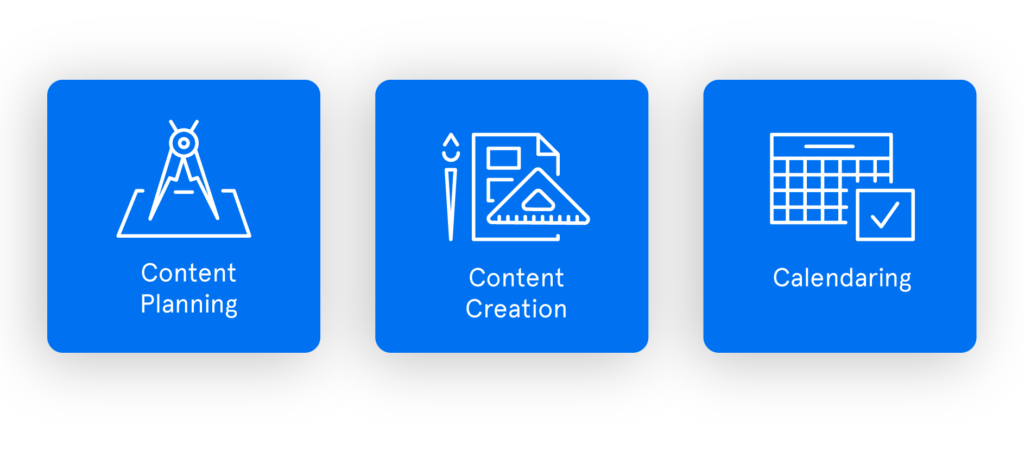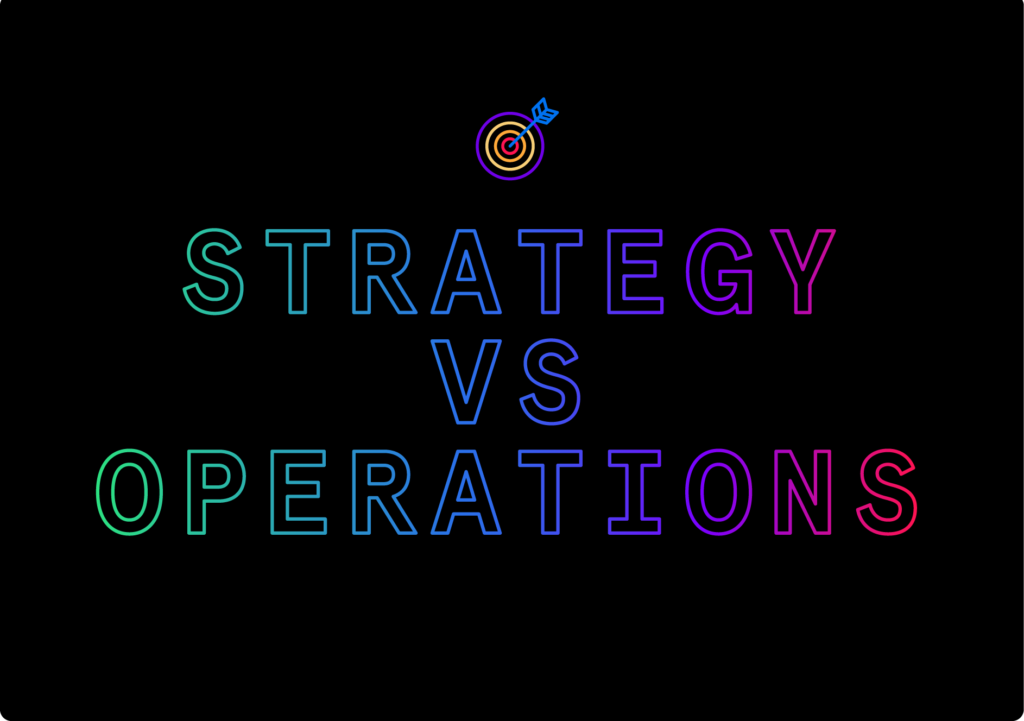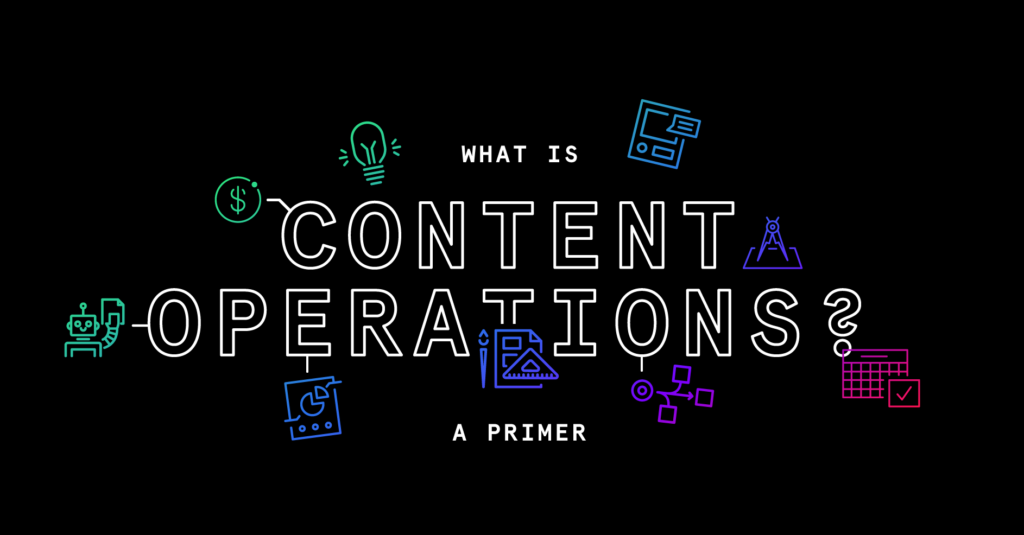by Lee Dussinger
Content is the lifeblood of marketing. Whether you define it as the dominant image for a billboard, a targeted social media campaign, a Super Bowl ad, or a line of copy on your homepage – all of these are various types of content.
As distribution channels proliferated, marketers began to discover the need for better content processes to successfully keep up. Where once there was only marketing chaos, there are now careful processes giving shape to creative work. The rise of the content operations platform and this field of study is the logical (and AWESOME) conclusion of this natural evolution…
So, exactly what is content operations?
Content operations is defined as the processes and tools that govern content at every stage of its life cycle – beginning to end. That means EVERYTHING from identifying the ideal publishing date of your social post, to analyzing the effectiveness of all your varied efforts, lives under this umbrella.
However, this simple definition is truly just the tip of the iceberg. We’re digging into the complete framework, content operations software, our platform, and much more!
Forrester Research Group’s Content Operations Model
While a single-sentence content operations definition might be sufficient to grasp the big picture idea, more detail is better. A nuanced concept like this one requires specifics if you want to truly understand it – and especially if you want to implement your own strategy. Content operations is not a single piece of software, best practice, job title, or a specific practice you implement – it is much more wide ranging than any of that.
As is the case with most hot-button marketing topics, different understandings of content operations have been floated around on the internet. However, the most complete definition comes from the Forrester Research Group. The highly-regarded, international market research firm recently created an 8-part breakdown of what content ops entails in the modern marketing landscape.

If you want to fully explore this topic, there’s no more comprehensive source than Forrester’s content operations model. We’re breaking down the 8 buckets right here – and highlighting what each module governs:
Content Planning
This represents the upstream planning element of content production. Everything from ideating on product launch collateral, to brainstorming an ambitious content marketing campaign, belong under this umbrella. Content planning often involves much of your team collaborating on briefs, strategy documents, concepts, and plans that are months, quarters, or even years away from hitting the market. Once upon a time, these essential creative first steps were fragmented, chaotic, and often done in silos. The content operations process strives to create a consistent – and often collaborative – method of planning. While working in a marketing planning platform makes this whole process easier, there are no wrong ways to execute content planning – provided you come away from the brainstorming session ready to build content.
According to Forrester, only 16% of B2B marketing organizations have advanced content planning processes in place.
Content Creation
In the Forrester content operations model, creation follows planning. During this phase of the model, writers write, photographers shoot, and designers go to work. While content creation is one of the most straightforward pieces to define, there are some nuances here to consider. For example, the processes around content feedback and approval are governed here as well. Depending on your workflows, securing the necessary internal approvals can take longer than creating the work itself. Dedicating analysis and resources to this module can deliver superior content, a greater sense of how your brand appears in the market, and dramatically decreased approval times. Discover how Microsoft cut their content approval time in half.
We’re able to produce way more in about half the amount of time, because we got ourselves out of email, spreadsheets, and chat.
Allison Kraker, Senior Product Marketing Manager, Microsoft
Calendaring
Calendaring can be confused with content planning as both represent a planning function. However, during calendaring you define the specific date and time for each piece of content to be deployed or published. In contrast, upstream content planning is often more conceptual and free-form. Above all, calendaring is a precise process of organizing specific dates and times across your marketing channels. One of the most essential buckets under content ops, effective calendaring is needed to prevent content gaps or collisions, while ensuring a unified brand identity. Calendaring also requires paying attention to your media mix as well as the flighting of your campaigns. Effective calendaring becomes more challenging the more people, brands, and regions are involved in content publishing.
Budget & Capacity Planning
Savvy leadership needs to understand what their team has the capacity to produce and what they have the budget to support in the market. Budget and capacity planning ensures that when content planning begins, realistic goals are set. This stage of the operations model governs human hours available, budgets needed to support those efforts, and more. Essentially, this sets the tone for the scope of content you produce and the outcomes you can expect.
Workflow Automation
In the modern marketing landscape, content production is a multifaceted endeavor that involves numerous professionals (often from inside and outside of your organization). Nearly gone are the days when a single content auteur executed every step of the process alone. The workflow automation component of content operations primarily focuses on activating the right people at the right time. Since there are often multiple moving parts for each piece of content, automating the process means accelerated work and less manual effort. As an added advantage, workflow automation can prevent errors by ensuring people aren’t left out via human error. Because when people are skipped or when work happens out of order, mistakes can be made.
Asset Management
Governing the use of video or visual assets is more complicated than many realize – and requires specific attention. Ensuring that your team knows the approval status of an asset, on what platforms it can be used, in what areas, and in what context, is essential for both legal and brand governance reasons. This holds especially true when your team builds content at-scale. There is a whole category of software built to solve these challenges. A DAM (digital asset management) is a platform built to give users full control and visibility over an asset. While Forrester’s model doesn’t explicitly require a DAM, these platforms make visual asset management much easier – especially for an enterprise organization.
Omni-Channel Distribution
While there will be exceptions, content often rarely lives exclusively on one platform. That makes distribution of omni-channel content a crucial piece of the operations puzzle. While posting and placing content natively is certainly an option, many organizations look to add efficiency here. This often necessitates using a platform to schedule and simultaneously distribute your work. Numerous publishing tools with different specialties (paid, social, or organic) can be found throughout the market. Adopting one of these tools is often an early step when implementing content operations best practices. Learn more about Opal Integrations.
AI & Analytics
Analyzing the content you create is just as essential as creating it in the first place. For that reason, analytics and AI are the final module in Forrester Research Group’s model. Since AI learning is often a driving force behind content analytics strategies, AI and analytics are grouped together in this module. In the modern marketing landscape, the main targets for AI analysis are lead attribution, sentiment analysis, and social media performance. One important qualifier to keep in mind is that although Forrester brackets AI and analytics together, they are not required to be linked. Yes, typically an enterprise organization will entrust a significant portion of their analytics to AI software. However, that is not a requirement – manual data analysis remains effective for smaller data sets.
According to Forrester research, 42% of B2B marketers rate themselves as beginners at managing content performance.
Dedicated Content Operations Software

As this discipline becomes essential for cutting-edge marketing teams, content operations software is taking center stage. Marketing leaders are looking for purpose-built tools to empower their teams to make the most of this operational framework.
General purpose software (like Monday, Airtable, and Asana) can provide some coverage – and many teams start there before migrating to dedicated solutions. However, a true content operations platform weaves together multiple content ops modules together. By bringing these functions together in one space, you gain context on all your content and you ensure the same strategic thread is carried through the entire process.
See more about content ops for exclusively digital content!
Using software that focuses on planning, creating and calendaring, you would begin brainstorming in a specific content planning space. Once plans are finalized, the software would activate the team, who would begin working off of the ideas and briefs created during planning. After the content is produced and approved in the platform, you would move it onto the calendar to place it alongside the rest of your work for maximum impact.
By having these three intertwined elements governed by one piece of content operations software, you ensure a seamless transfer from phase to phase. While in theory you could perform many of those functions in a general work management platform, they would not be interconnected, causing a noticeable loss in team efficiency.

Why Does Content Ops Matter?
Content operations matters because quality content executed as part of a larger strategy matters. A stronger operational framework delivers tangible benefits for the content produced, the outcomes it drives, and the experience of working on the content team. In fact, some marketing leaders who evangelize for content ops compare it to DevOps – as far as the potential impact and how ubiquitous it should be in modern organizations.
As powerful as this operations framework can be, according to Forrester’s recent survey, only 10% of marketers have a concrete plan or process built around it. Those that do, however, reap these rewards:
Guarantee Brand Alignment – When content calendaring is unorganized, the potential for error grows. The more people who create and distribute content, the greater the risk of mistakes becomes. These errors can look like overlapping content, extended periods where no content is published, or simply completely misaligned brand voices or messaging. By achieving alignment through platforms and processes, you guarantee that you show up as one brand to your audience.
Achieve Efficiency – One of the salient benefits of the digital operations model is boosted efficiency. First and foremost, the workflow automation component specifically cuts busywork in favor of work that matters. In addition to that, repeatable processes and content operations platforms have been shown to save significant time in the often lengthy cycle of content feedback and approvals. The ability to move faster and to eliminate wasted time enables teams to create more. Many ops professionals consider the investment in efficiency akin to bringing aboard a whole other person on the content team!
It may be anecdotal – but on average, when our customers plan and visualize their content in Opal, they are able to expedite their content production by days or even weeks. Peak efficiency: see how Target creates 300 pieces of content per day with Opal.
“I can’t even tell you how many hours Opal has saved our team in planning content and using that as our source of truth!”
Target Marketing Team
Maximize the Bang for Your Buck – Several buckets throughout the Forrester model help your content pack an extra punch in the market. Firstly, a strong planning framework creates the conditions that consistently generate your A+ concepts and ideas. On top of that, putting focus on analysis most directly improves the impact of what you produce. Whether you analyze the performance of your content with automated tools or you do it manually, the outcome is a superior understanding of what works – and why.
Recreate Effective Brainstorming – Without a framework, capturing creative lightning in a bottle can feel nearly impossible. By having a process or platform in place to guide your brainstorming, you can more reliably achieve your “aha” moments. Whether that looks like using a planning platform with a function for high-level planning, or simply setting recurring time to ideate, enforcing a process unlocks creative potential. In addition, maintaining a formal framework enables you to more easily turn those lofty ideas into actionable briefs or to simply share them with the rest of the team.
Dig deeper into how processes can stimulate creativity!

Content Strategy vs Operations
Having a rock-solid content operations definition is crucial to understanding the model and how you can implement it. However, marketers often wonder how it differs from content strategy.
At its core, the difference between content strategy and content operations is the “what and why” vs the “how”. In short, content strategy is the goal you want to accomplish via content and the specific pieces of content you produce to achieve it. Content operations is the framework around, and the analysis of, that strategy. That difference can be difficult to see in the abstract, though. Let’s explore the difference between content strategy and ops through three buckets in Forrester’s model: content planning, content creation, and calendaring.
Strategy vs Ops: Content Planning
In the content planning stage, the big ideas you brainstorm, the briefs you write, and the assets you create represent your content strategy. On the other hand, the proven process you have around upstream ideation (for example, hosting weekly brainstorming meetings) and the platform you use to store your content briefs are on the operational side.
Strategy vs Ops: Content Creation
When creating content, what you produce and what you hope to achieve with it is content strategy. The workflow that guides your production is the operations element. For example, having a formal set of approvals to ensure each piece of content is fully vetted for publication is operations in its simplest form. Of course, teams can also invest in a dedicated content operations platform that streamlines this process by centralizing content production, offering true-to-life previews, and activating individual team members when their contribution is needed.
Strategy vs Ops: Calendaring
Looking at calendaring, the content strategy is knowing that you need to utilize content reliably in order to grow your audience. Smart strategy stipulates the best practice of not overlapping your content or allowing huge gaps – while maintaining a fully unified voice in the market. Following content operations’ best practices involves having a set of processes, double checks, and platforms that ensure your calendaring adheres to those best practices…every time.
Who is On the Content Operations Team?
Some organizations will have a dedicated content operations team that works to manage processes for the content production cohort. In other – often smaller – organizations, the content creation team leads the operational thrust as well. After all, they have the greatest familiarity and the most to gain from optimizing their processes. However, the operations side of content has become a quickly growing career path – especially as this new discipline becomes front of mind for CMO’s and other senior leadership team members. Looking at major job boards reveals numerous positions, at different skill and experience levels, for this discipline.
Whether you’re looking to build this team at your company or you’re considering it as a career path, looking into specific roles is important. Here are a few of these types of roles:
- Content Operations Coordinator – The associate-level position, the content operations coordinator works closely with the content production team and does much of the day-to-day process improvements. Primary duties include designing process guides, analyzing current processes for inefficiencies, and reporting on insights.
- Content Operations Manager – In the majority of organizations, the manager is the top role. Generally, this role is responsible for ensuring content operations’ best practices are being followed, reporting insights to company leadership, and choosing the software for the content creation and operations teams.
- Content Operations Director – In select cases, large enterprise organizations will have a director-level position. This role primarily entails setting big picture goals, ensuring ops is meeting business priorities, and interfacing with other department leads.
At this point in 2022, the majority of content operations teams are located in the marketing departments of enterprise companies. In addition to that, dedicated content agencies often maintain an operational team to support their bread and butter content creation function. As the need for content grows, the operational component will almost certainly grow along with it.

The Dedicated Content Operations Platform
There’s a reason we at Opal want to define content operations, illustrate how it works, and highlight its best practices. That reason is because Opal has been a content operations platform before the term ever existed.
Opal was purpose-built for content teams to plan, create, and schedule their work all in one place. Before the term had ever been coined, marketers trusted Opal to streamline their workflow, view complex schedules on a central calendar, and truly understand how their brand appeared in the market.
Since no one software tool can do everything (or at least do everything well), the Opal platform focuses on the Forrester modules of content planning, content creation, and calendaring. We empower marketers to take control of their content through a variety of purpose-built features and key integrations – specifically designed to meet the needs of some of the world’s top marketers…our customers.
Some of the most-recognized, most-loved brands – like Target, Starbucks, and Microsoft – plan, create, and calendar their content in Opal.
If you’re ready to explore all the capabilities of Opal for yourself, we’d love to show you everything the platform has to offer.
Consider scheduling a custom demo with a platform expert right here. Of course, if you’d rather take a hands-on approach, we invite you to sign up for a free 30-day trial!


